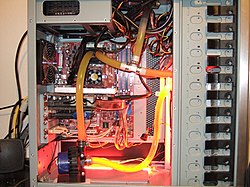Overclocking
Overclocking is the process of configuring a computer processor or other electronic circuit to run faster than it was designed to. Overclocking allows a computer to be faster and more responsive. Overclocked processors tend to use more electricity and make more heat than those running at their intended speed. It is often necessary to install a better heat sink to avoid overheating the processor. If a processor is overclocked too high, it can damage the processor or make the computer unstable. Increasing the voltage to the processor can allow it to be run at even higher speeds where it would otherwise be unstable, but this carries an especially high risk of damaging the processor.
Overclocking is usually done in the computer's BIOS setup utility. Most brand-name computers such as Dell, HP, and others do not allow overclocking in the BIOS setup utility, but custom-built computers usually do. It is also possible to do the opposite, called underclocking, where the processor is run at a lower speed than intended. This may be done to extend battery life and reduce heat output. Underclocking will not usually damage a processor and may in fact make it last longer. Some processors automatically underclock themselves when the computer is not doing a lot of work.
Overclocking of other components
Many other digital circuits with a clock signal can be overclocked (or underclocked). This includes video cards, smartphones, and even graphing calculators. Even some sound cards can be overclocked to record or play at a higher sample rate than usual. Overclocking has become popular with Android users.[1]
Overclocking Media
Overclocking BIOS setup on an ABIT NF7-S motherboard with an AMD Athlon XP processor.
High quality heat sinks are often made of copper.
Liquid nitrogen may be used for cooling an overclocked system, when an extreme measure of cooling is needed.
The BFG GeForce 6800GSOC ships with higher memory and clock rates than the standard 6800GS.
References
- ↑ "The Risks and Rewards of Overclocking Android Phones - Tested.com". Tested. Archived from the original on 2019-12-15. Retrieved 2019-12-15.




